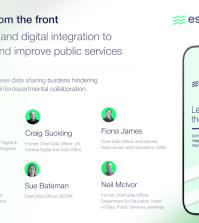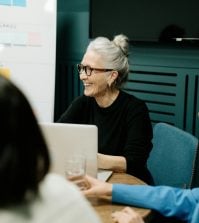Smart fellows: Kok Ping Soon on leading Singapore’s digital government army

As every digital leader knows, technology is a people issue – and no country has better technology people than Singapore. In his last weeks as a civil servant after five years running the country’s Government Technology Agency, Kok Ping Soon explains his unorthodox approach to workforce development
“Often, when we bring high-end technical talent into an organisation, we think: ‘Where do I put that person? Is there a particular job for them to do?’ And we put them in a box,” muses Kok Ping Soon. “But we’re rethinking that, because there may not be a box for them. Instead, I want to let them draw the box.”
As his five-year stint as chief executive of the Government Technology Agency of Singapore (GovTech) draws to a close, Kok is reflecting on his ‘Smart Nation Fellows’ programme. Pairing brilliant, mid-career technologists from the private sector with “bureaucracy hackers” who can help them navigate the public sector environment, the initiative gives people the space to pursue their passions – attracting world-class talent to generate both new products, and learning opportunities for the permanent workforce.
One fellow, recalls Kok, “wanted to do ‘beyond visual line of sight’ capability on an autonomous robot. I let him hire a team, and he delivered a capability that came to be used during COVID: we had robot dogs running around, helping with social distancing”. Like the Fellows who developed an API marketplace and designed a Cloud-based tech stack, Kok adds, this individual has now returned to the private sector, “but that’s okay: the important thing is what they contributed”. GovTech retains the intellectual property, he explains, and former Fellows continue to provide staff with mentoring, advice and assistance.
The programme illustrates Singapore’s remarkable approach to digital – and, more broadly, to civil service management. The city-state’s government is highly organised, operating tightly-defined processes and policies governing every public sector activity. But leaders keep a careful lookout for perverse incentives and weaknesses within this complex web of rules, and have the imagination and confidence to introduce modifications or exemptions – building systems flexible and nuanced enough to cope with the messy world of human behaviours and organisational dynamics. A unique scheme that rewrites the rules of civil service recruitment, the Smart Nation Fellows programme brings in digital talent that would otherwise remain beyond the reach of the civil service.
From threat to asset
A similar approach can be seen across GovTech’s workforce development policies, which transform the country’s strong domestic tech sector – a potential threat to civil service recruitment and retention – into a major asset. In recent years, Kok explains, Singapore’s IT sector has developed rapidly, with the tech giants adding development labs to their existing sales and regional support operations. That has encouraged Singaporean technologists working overseas to return home, while generating a pipeline of highly skilled, experienced staff; to attract them, Kok plays carefully on the civil service’s unique advantages.
It’s crucial first, he explains, to address “hygiene factors” such as salaries: pay rates for digital civil servants are close to those of their private sector peers. Like its private sector competitors, GovTech also offers undergraduate internships and scholarships that produce a stream of newly-qualified recruits. But Kok can also sell the opportunity to improve public services, and the freedom to address a problem from end to end. Working for the tech giants, Kok explains, people are often “focusing on a very, very niche area of a global-scale problem”. At GovTech, though, they can “solve a data science problem for a whole ministry. It’s not a planet-scale problem, but it’s a more complete one”.
Once on board, technologists are given as much autonomy as possible, and – like the Smart Nation Fellows – paired with experienced officials who can help address “the irritants of working in a bureaucracy,” taking on administrative tasks such as funding applications and procurement processes. Staff must also have “opportunities to continue to develop their tradecraft; to gain mastery in their skills” – both through training provision, and by working with inspirational figures such as the Fellows. “Finally, we must make sure that the individual builds a team around them, or is immersed in a team,” Kok concludes. “People join organisations, but leave because of people.”
Digital and beyond
He pays almost as much attention to the skills of the non-digital workforce, providing a course that “leads people through the product development process, based on design thinking”. Trainees then apply these skills in their working lives, coming together at the outset of a project “for the technologists to understand the operational problem; and for the officers to learn about ‘agile’, scrums, story points, the daily stand-up, so they can actively participate”.
Crucially, permanent secretaries also receive bespoke training in the capabilities, nature and requirements of digital technologies – including a ‘leading digital transformation’ course developed with Harvard University’s John F Kennedy School of Government. “Do I want all my permanent secretaries to be programmers? No,” Kok comments. “But I want them to know enough to be dangerous: to ask the right questions, and to steer and guide the team.” Has Singapore yet built a leadership cadre that gets digital? “Not yet,” he replies with a grin. “Trying!”
In his new role, he’ll continue pursuing that mission within the private sector: Kok is currently combining his GovTech job with that of chief executive officer at representative body the Singapore Business Federation, and on 1 June will complete the transition and leave the civil service. While his whole career to date has been inside government, it’s easy to see why the Federation wants him on board: his first decade was spent attracting investors, staff and tourists to Singapore, and he’s since held senior roles at the Ministry of Trade & Industry and the Ministry of Manpower.

His civil service experience will also be helpful in the federation’s work to provide its members with services – for GovTech generates most of its income by charging ministries and agencies for digital staff, devices, services and infrastructure (it also receives central funding to build new products and capabilities). To meet these responsibilities, GovTech employs 3,500 people across government. Keeping this widely-distributed workforce pointing in the same direction, Kok comments, requires “over-communication” with GovTech’s staff: he constantly reiterates core messages about the agency’s purpose and culture. “After a while, I get a bit tired of saying the same thing,” he says. “I’ve always got to find a new spin, a bit of new context. But it’s the only way you can get organisational alignment.”
On centralisation and customisation
It’s just as crucial, Kok adds, to engage with civil service leaders across government: GovTech will only succeed if agency chiefs recognise its value in helping them realise their public policy goals. “Getting the alignment of what technology can do to service the mission requires a lot more engagement; more talking,” he comments.
To shepherd ministries and agencies towards a common set of digital policies, standards and working practices, GovTech and the Smart Nation and Digital Government Office – its policy-focused sister organisation – oversee a Ministry Family Digitalisation Plan, developed with the chief digital strategy officers (CDSOs) appointed to every government body. Individual agencies are incentivised to show ambition here by the prospect of central funding for elements of their own digitalisation plans, and their progress is monitored via a “digital maturity index: a self-scoring survey that lets them evaluate where they are”.
Within this framework, Singapore has already introduced many common standards and shared tools – and GovTech is now, says Kok, “not just focusing on the standardising the front end; we are also standardising the way future applications are developed”.
This relates to the “CI/CD tool chain”: standardising the ‘Continuous Integration, Delivery and Deployment’ process enables new tools to be integrated seamlessly into systems across government. So if one agency wants to build a tool that might be useful to others across government, GovTech can fund its development, then bring it into Singapore’s tech stack and make it available to everyone.
Despite this push for standardisation, Kok recognises that there’s always a “balance between trying to do centralisation and customisation”. Agencies must remain in charge of “the definition of the problem and the outcome that they want,” he comments, and retain “enough free space to spin up new applications or try new programming languages”. He’s keenly aware of the risks attached to requiring agencies to adopt common tools or systems: it’s important that GovTech’s offers are “better, faster, cheaper than whatever solutions they have,” he notes. “Be careful what you mandate!”
The spine for success
Having said that, Kok is clear that the mandate requiring agencies to use Singapore’s digital ID system, Singpass, has been central to its success. Shortly after the system was launched in 2003, he recalls, “we stopped different agencies from using their own [systems]. Once we got that done, we were able to leapfrog through various variations” – adding new authentication processes such as facial recognition, and the ‘MyInfo’ service that provides a single source of truth for personal data. Meanwhile, GovTech has been careful to make Singpass really useful to citizens, inviting banks and other service providers to adopt the system: enabling people to conduct a huge range of everyday transactions, Singpass is now used by 97% of the country’s over-15s.
In Kok’s view, the next stage in Singpass’s evolution should involve making it interoperable with other countries’ digital ID systems – enabling travellers and those studying or working abroad to more easily access services. “Technical interoperability is not difficult,” he says, pointing to the EU’s eIDAS framework as a model. However, “progress has not been as fast as we hoped”: there’s a need for “political will to explore use cases”. Ultimately, he believes, digital IDs could become “like the next generation of passports.”
Like its approach to the digital workforce, Singapore’s development of Singpass illustrates its civil servants’ ability to make innovation systemic – constantly adjusting policies and systems to address real-world problems. And there’s another striking example, found within that most rule-bound of public sector activities: procurement.
A retail revolution
GovTech staff can, Kok explains, spend up to S$250,000 (UK£150,000) on experimental development work over six months without going through the normal procurement process – allowing people to test out radical and innovative ideas. “For innovation to happen, initially you don’t need a big amount of money,” he comments. “There can be many low fidelity ways of getting things done and testing a proposition.” Where the results are promising, project managers can side-step the full tender process by spending up to S$2m (UK£1.2m) buying tools or services from pre-approved suppliers.

Still more remarkably, GovTech has worked with the Ministry of Finance to incorporate elements of ‘agile’ project management into the governance and approval of large-scale development work – moving on from the ‘waterfall’ methodology that sits so awkwardly with digital projects.
Rather than requiring project owners to specify exactly what they’re building before beginning development, Kok says, finance managers first give in-principle approval to the over-arching concept, then release tranches of money to fund individual ‘sprints’. “Scrutiny is not based on the specifications of the system, because we’ve not decided yet what to build,” Kok explains. Instead, before receiving funding for each new sprint project managers must “convince us that it’s a worthwhile problem to solve,” and show that their method, success metrics and cost estimates are robust.
So budget holders do not demand detailed delivery plans in advance, as if they know best how to build a digital project. Instead, they check digital leaders’ assumptions and working practices, then trust the experts to get on with the job. Again, Singapore’s approach here shows how processes can be built that support professionals rather than constraining them, creating that rare thing: a nimble bureaucracy.
It also illustrates the power of Kok’s approach to workforce development – an approach built around attracting top-quality talent, then giving people the freedom and skills to thrive. “Get the hygiene factor right, by paying competitively but not leading the market; get the purpose right; focus on autonomy; and then work on mastery,” he concludes. Let people draw their own boxes, and you’ll create an organisation that thinks outside them.
Kok Ping Soon recently attended GGF’s Innovation 2023 conference in London. You can watch him speak during the panel session on ‘A Culture of Innovation’ via our On Demand page.























